Analysis and Critique: Purcell et al.'s 'A Study of Women Who Stalk'
VerifiedAdded on 2023/01/19
|6
|1885
|88
Report
AI Summary
This report presents a comprehensive critique of the research article "A Study of Women Who Stalk" by Purcell, Pathé, and Mullen (2001). The report examines the study's objectives, which focus on understanding the motivations, behaviors, and potential for violence associated with female stalking. It analyzes the methodology, including the use of surveys, and discusses the key findings regarding the prevalence of female stalkers, contrasting them with male stalkers and highlighting the importance of gender-neutral definitions of stalking. The critique delves into the strengths of the paper, such as its in-depth analysis and use of surveys, while also pointing out weaknesses, including the lack of a literature review and limited discussion of the negative impacts of women stalking. The report references other studies to support and challenge the original paper's conclusions, providing a balanced assessment of the research's contributions to the field of forensic psychology and its implications for understanding stalking behavior and its consequences. The report concludes with a summary of the key arguments and findings, emphasizing the need for further research in this area.

A Study of Women Who Stalk
Paraphrase This Document
Need a fresh take? Get an instant paraphrase of this document with our AI Paraphraser
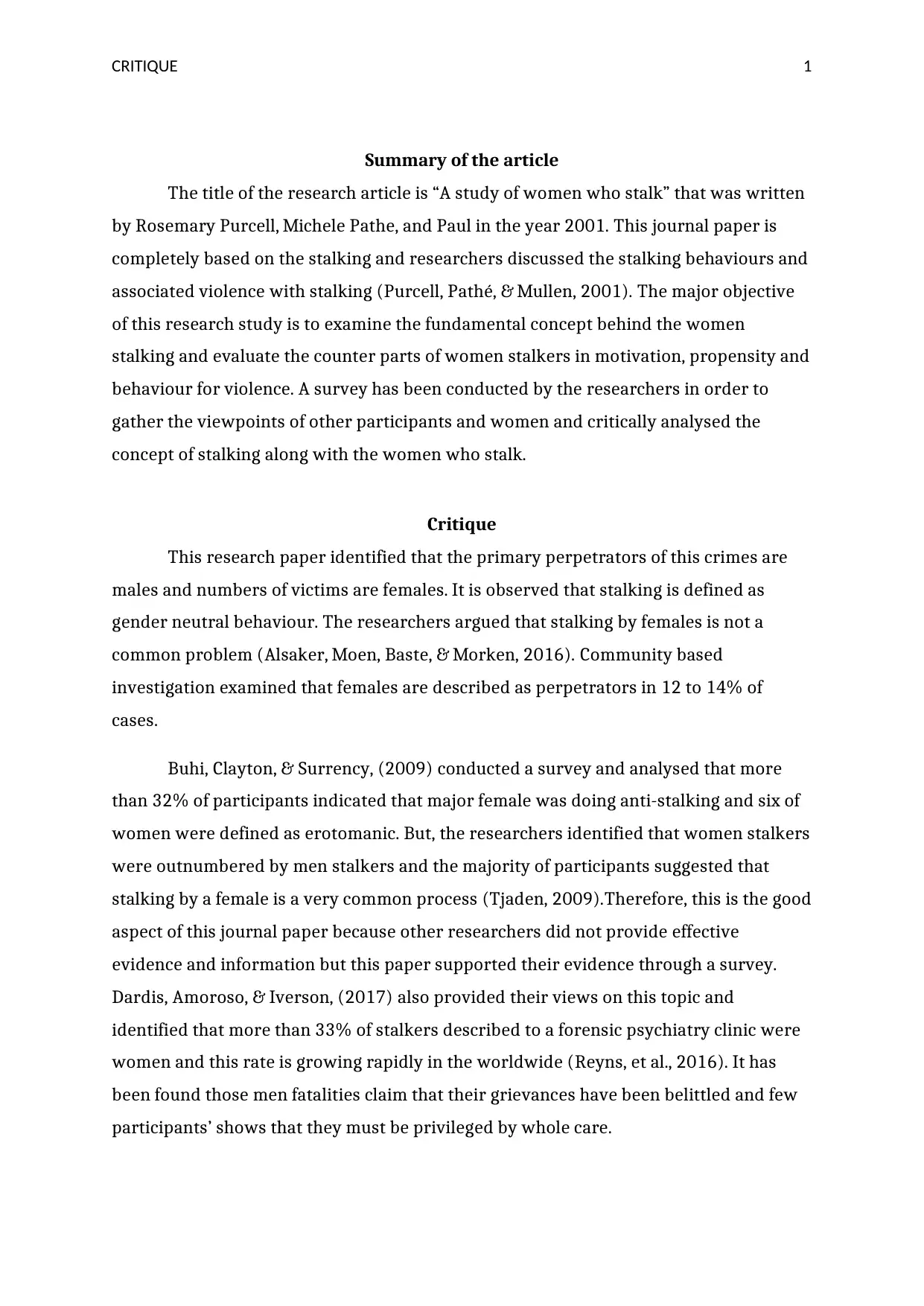
CRITIQUE 1
Summary of the article
The title of the research article is “A study of women who stalk” that was written
by Rosemary Purcell, Michele Pathe, and Paul in the year 2001. This journal paper is
completely based on the stalking and researchers discussed the stalking behaviours and
associated violence with stalking (Purcell, Pathé, & Mullen, 2001). The major objective
of this research study is to examine the fundamental concept behind the women
stalking and evaluate the counter parts of women stalkers in motivation, propensity and
behaviour for violence. A survey has been conducted by the researchers in order to
gather the viewpoints of other participants and women and critically analysed the
concept of stalking along with the women who stalk.
Critique
This research paper identified that the primary perpetrators of this crimes are
males and numbers of victims are females. It is observed that stalking is defined as
gender neutral behaviour. The researchers argued that stalking by females is not a
common problem (Alsaker, Moen, Baste, & Morken, 2016). Community based
investigation examined that females are described as perpetrators in 12 to 14% of
cases.
Buhi, Clayton, & Surrency, (2009) conducted a survey and analysed that more
than 32% of participants indicated that major female was doing anti-stalking and six of
women were defined as erotomanic. But, the researchers identified that women stalkers
were outnumbered by men stalkers and the majority of participants suggested that
stalking by a female is a very common process (Tjaden, 2009).Therefore, this is the good
aspect of this journal paper because other researchers did not provide effective
evidence and information but this paper supported their evidence through a survey.
Dardis, Amoroso, & Iverson, (2017) also provided their views on this topic and
identified that more than 33% of stalkers described to a forensic psychiatry clinic were
women and this rate is growing rapidly in the worldwide (Reyns, et al., 2016). It has
been found those men fatalities claim that their grievances have been belittled and few
participants’ shows that they must be privileged by whole care.
Summary of the article
The title of the research article is “A study of women who stalk” that was written
by Rosemary Purcell, Michele Pathe, and Paul in the year 2001. This journal paper is
completely based on the stalking and researchers discussed the stalking behaviours and
associated violence with stalking (Purcell, Pathé, & Mullen, 2001). The major objective
of this research study is to examine the fundamental concept behind the women
stalking and evaluate the counter parts of women stalkers in motivation, propensity and
behaviour for violence. A survey has been conducted by the researchers in order to
gather the viewpoints of other participants and women and critically analysed the
concept of stalking along with the women who stalk.
Critique
This research paper identified that the primary perpetrators of this crimes are
males and numbers of victims are females. It is observed that stalking is defined as
gender neutral behaviour. The researchers argued that stalking by females is not a
common problem (Alsaker, Moen, Baste, & Morken, 2016). Community based
investigation examined that females are described as perpetrators in 12 to 14% of
cases.
Buhi, Clayton, & Surrency, (2009) conducted a survey and analysed that more
than 32% of participants indicated that major female was doing anti-stalking and six of
women were defined as erotomanic. But, the researchers identified that women stalkers
were outnumbered by men stalkers and the majority of participants suggested that
stalking by a female is a very common process (Tjaden, 2009).Therefore, this is the good
aspect of this journal paper because other researchers did not provide effective
evidence and information but this paper supported their evidence through a survey.
Dardis, Amoroso, & Iverson, (2017) also provided their views on this topic and
identified that more than 33% of stalkers described to a forensic psychiatry clinic were
women and this rate is growing rapidly in the worldwide (Reyns, et al., 2016). It has
been found those men fatalities claim that their grievances have been belittled and few
participants’ shows that they must be privileged by whole care.
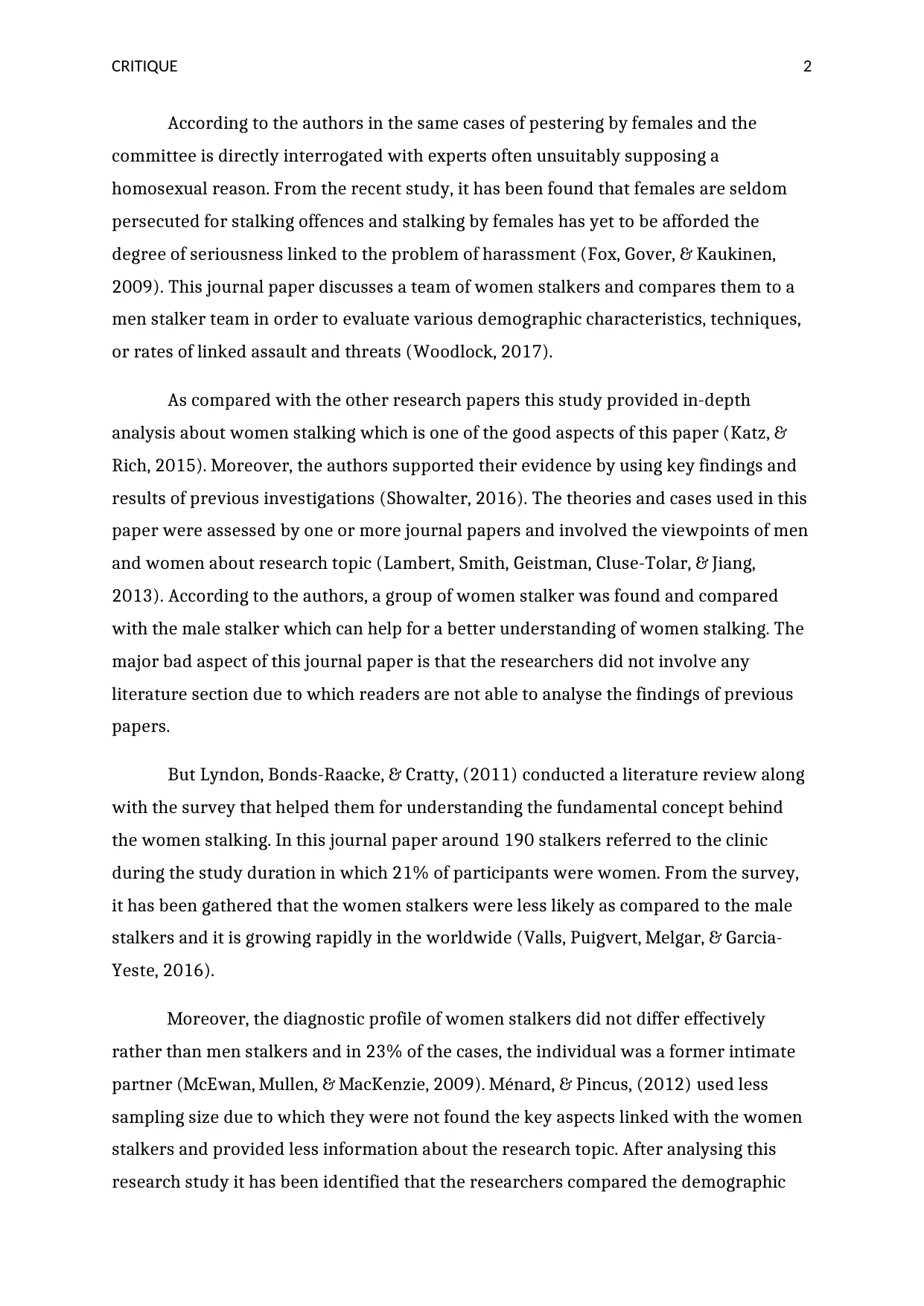
CRITIQUE 2
According to the authors in the same cases of pestering by females and the
committee is directly interrogated with experts often unsuitably supposing a
homosexual reason. From the recent study, it has been found that females are seldom
persecuted for stalking offences and stalking by females has yet to be afforded the
degree of seriousness linked to the problem of harassment (Fox, Gover, & Kaukinen,
2009). This journal paper discusses a team of women stalkers and compares them to a
men stalker team in order to evaluate various demographic characteristics, techniques,
or rates of linked assault and threats (Woodlock, 2017).
As compared with the other research papers this study provided in-depth
analysis about women stalking which is one of the good aspects of this paper (Katz, &
Rich, 2015). Moreover, the authors supported their evidence by using key findings and
results of previous investigations (Showalter, 2016). The theories and cases used in this
paper were assessed by one or more journal papers and involved the viewpoints of men
and women about research topic (Lambert, Smith, Geistman, Cluse-Tolar, & Jiang,
2013). According to the authors, a group of women stalker was found and compared
with the male stalker which can help for a better understanding of women stalking. The
major bad aspect of this journal paper is that the researchers did not involve any
literature section due to which readers are not able to analyse the findings of previous
papers.
But Lyndon, Bonds-Raacke, & Cratty, (2011) conducted a literature review along
with the survey that helped them for understanding the fundamental concept behind
the women stalking. In this journal paper around 190 stalkers referred to the clinic
during the study duration in which 21% of participants were women. From the survey,
it has been gathered that the women stalkers were less likely as compared to the male
stalkers and it is growing rapidly in the worldwide (Valls, Puigvert, Melgar, & Garcia-
Yeste, 2016).
Moreover, the diagnostic profile of women stalkers did not differ effectively
rather than men stalkers and in 23% of the cases, the individual was a former intimate
partner (McEwan, Mullen, & MacKenzie, 2009). Ménard, & Pincus, (2012) used less
sampling size due to which they were not found the key aspects linked with the women
stalkers and provided less information about the research topic. After analysing this
research study it has been identified that the researchers compared the demographic
According to the authors in the same cases of pestering by females and the
committee is directly interrogated with experts often unsuitably supposing a
homosexual reason. From the recent study, it has been found that females are seldom
persecuted for stalking offences and stalking by females has yet to be afforded the
degree of seriousness linked to the problem of harassment (Fox, Gover, & Kaukinen,
2009). This journal paper discusses a team of women stalkers and compares them to a
men stalker team in order to evaluate various demographic characteristics, techniques,
or rates of linked assault and threats (Woodlock, 2017).
As compared with the other research papers this study provided in-depth
analysis about women stalking which is one of the good aspects of this paper (Katz, &
Rich, 2015). Moreover, the authors supported their evidence by using key findings and
results of previous investigations (Showalter, 2016). The theories and cases used in this
paper were assessed by one or more journal papers and involved the viewpoints of men
and women about research topic (Lambert, Smith, Geistman, Cluse-Tolar, & Jiang,
2013). According to the authors, a group of women stalker was found and compared
with the male stalker which can help for a better understanding of women stalking. The
major bad aspect of this journal paper is that the researchers did not involve any
literature section due to which readers are not able to analyse the findings of previous
papers.
But Lyndon, Bonds-Raacke, & Cratty, (2011) conducted a literature review along
with the survey that helped them for understanding the fundamental concept behind
the women stalking. In this journal paper around 190 stalkers referred to the clinic
during the study duration in which 21% of participants were women. From the survey,
it has been gathered that the women stalkers were less likely as compared to the male
stalkers and it is growing rapidly in the worldwide (Valls, Puigvert, Melgar, & Garcia-
Yeste, 2016).
Moreover, the diagnostic profile of women stalkers did not differ effectively
rather than men stalkers and in 23% of the cases, the individual was a former intimate
partner (McEwan, Mullen, & MacKenzie, 2009). Ménard, & Pincus, (2012) used less
sampling size due to which they were not found the key aspects linked with the women
stalkers and provided less information about the research topic. After analysing this
research study it has been identified that the researchers compared the demographic
⊘ This is a preview!⊘
Do you want full access?
Subscribe today to unlock all pages.

Trusted by 1+ million students worldwide
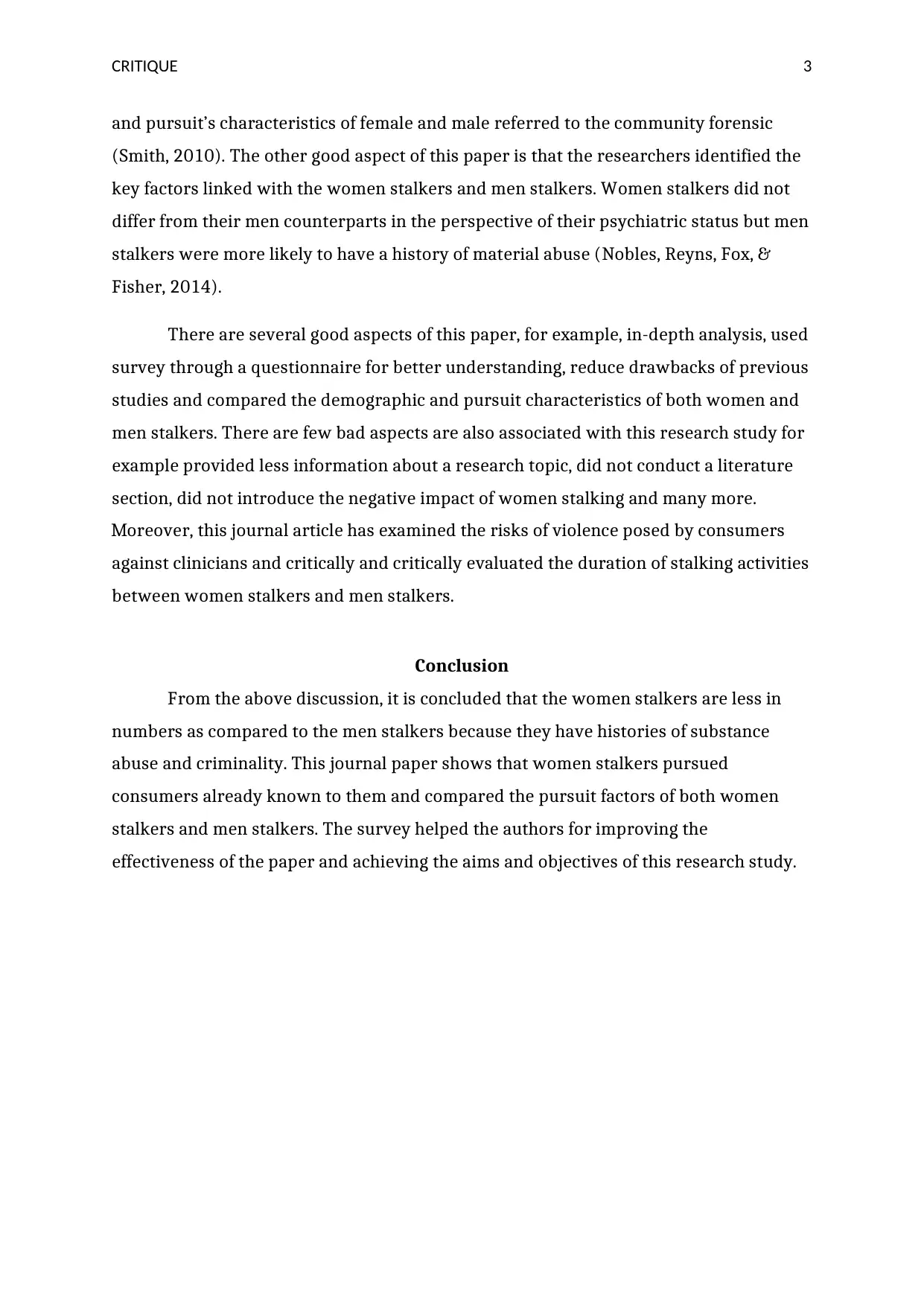
CRITIQUE 3
and pursuit’s characteristics of female and male referred to the community forensic
(Smith, 2010). The other good aspect of this paper is that the researchers identified the
key factors linked with the women stalkers and men stalkers. Women stalkers did not
differ from their men counterparts in the perspective of their psychiatric status but men
stalkers were more likely to have a history of material abuse (Nobles, Reyns, Fox, &
Fisher, 2014).
There are several good aspects of this paper, for example, in-depth analysis, used
survey through a questionnaire for better understanding, reduce drawbacks of previous
studies and compared the demographic and pursuit characteristics of both women and
men stalkers. There are few bad aspects are also associated with this research study for
example provided less information about a research topic, did not conduct a literature
section, did not introduce the negative impact of women stalking and many more.
Moreover, this journal article has examined the risks of violence posed by consumers
against clinicians and critically and critically evaluated the duration of stalking activities
between women stalkers and men stalkers.
Conclusion
From the above discussion, it is concluded that the women stalkers are less in
numbers as compared to the men stalkers because they have histories of substance
abuse and criminality. This journal paper shows that women stalkers pursued
consumers already known to them and compared the pursuit factors of both women
stalkers and men stalkers. The survey helped the authors for improving the
effectiveness of the paper and achieving the aims and objectives of this research study.
and pursuit’s characteristics of female and male referred to the community forensic
(Smith, 2010). The other good aspect of this paper is that the researchers identified the
key factors linked with the women stalkers and men stalkers. Women stalkers did not
differ from their men counterparts in the perspective of their psychiatric status but men
stalkers were more likely to have a history of material abuse (Nobles, Reyns, Fox, &
Fisher, 2014).
There are several good aspects of this paper, for example, in-depth analysis, used
survey through a questionnaire for better understanding, reduce drawbacks of previous
studies and compared the demographic and pursuit characteristics of both women and
men stalkers. There are few bad aspects are also associated with this research study for
example provided less information about a research topic, did not conduct a literature
section, did not introduce the negative impact of women stalking and many more.
Moreover, this journal article has examined the risks of violence posed by consumers
against clinicians and critically and critically evaluated the duration of stalking activities
between women stalkers and men stalkers.
Conclusion
From the above discussion, it is concluded that the women stalkers are less in
numbers as compared to the men stalkers because they have histories of substance
abuse and criminality. This journal paper shows that women stalkers pursued
consumers already known to them and compared the pursuit factors of both women
stalkers and men stalkers. The survey helped the authors for improving the
effectiveness of the paper and achieving the aims and objectives of this research study.
Paraphrase This Document
Need a fresh take? Get an instant paraphrase of this document with our AI Paraphraser
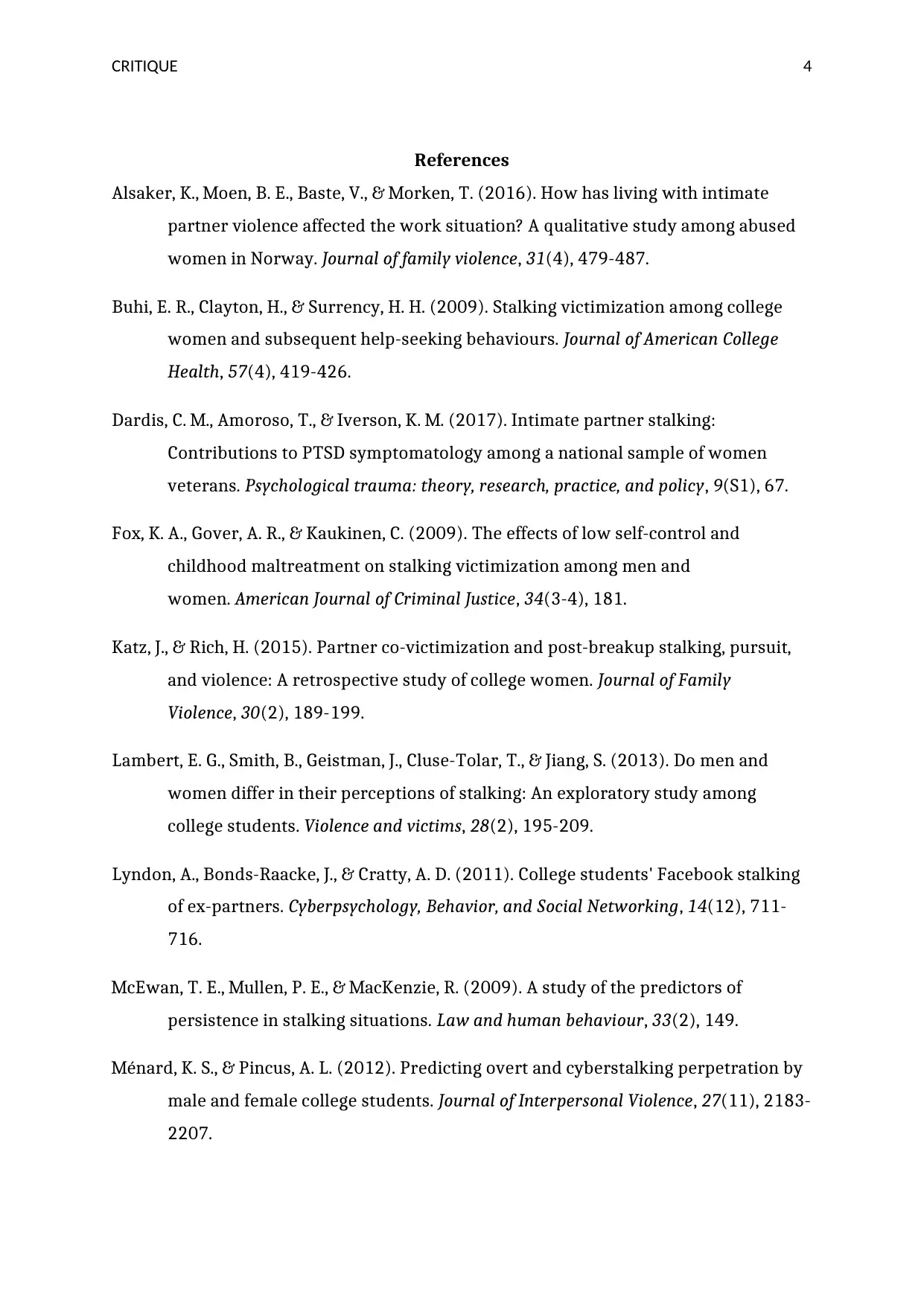
CRITIQUE 4
References
Alsaker, K., Moen, B. E., Baste, V., & Morken, T. (2016). How has living with intimate
partner violence affected the work situation? A qualitative study among abused
women in Norway. Journal of family violence, 31(4), 479-487.
Buhi, E. R., Clayton, H., & Surrency, H. H. (2009). Stalking victimization among college
women and subsequent help-seeking behaviours. Journal of American College
Health, 57(4), 419-426.
Dardis, C. M., Amoroso, T., & Iverson, K. M. (2017). Intimate partner stalking:
Contributions to PTSD symptomatology among a national sample of women
veterans. Psychological trauma: theory, research, practice, and policy, 9(S1), 67.
Fox, K. A., Gover, A. R., & Kaukinen, C. (2009). The effects of low self-control and
childhood maltreatment on stalking victimization among men and
women. American Journal of Criminal Justice, 34(3-4), 181.
Katz, J., & Rich, H. (2015). Partner co-victimization and post-breakup stalking, pursuit,
and violence: A retrospective study of college women. Journal of Family
Violence, 30(2), 189-199.
Lambert, E. G., Smith, B., Geistman, J., Cluse-Tolar, T., & Jiang, S. (2013). Do men and
women differ in their perceptions of stalking: An exploratory study among
college students. Violence and victims, 28(2), 195-209.
Lyndon, A., Bonds-Raacke, J., & Cratty, A. D. (2011). College students' Facebook stalking
of ex-partners. Cyberpsychology, Behavior, and Social Networking, 14(12), 711-
716.
McEwan, T. E., Mullen, P. E., & MacKenzie, R. (2009). A study of the predictors of
persistence in stalking situations. Law and human behaviour, 33(2), 149.
Ménard, K. S., & Pincus, A. L. (2012). Predicting overt and cyberstalking perpetration by
male and female college students. Journal of Interpersonal Violence, 27(11), 2183-
2207.
References
Alsaker, K., Moen, B. E., Baste, V., & Morken, T. (2016). How has living with intimate
partner violence affected the work situation? A qualitative study among abused
women in Norway. Journal of family violence, 31(4), 479-487.
Buhi, E. R., Clayton, H., & Surrency, H. H. (2009). Stalking victimization among college
women and subsequent help-seeking behaviours. Journal of American College
Health, 57(4), 419-426.
Dardis, C. M., Amoroso, T., & Iverson, K. M. (2017). Intimate partner stalking:
Contributions to PTSD symptomatology among a national sample of women
veterans. Psychological trauma: theory, research, practice, and policy, 9(S1), 67.
Fox, K. A., Gover, A. R., & Kaukinen, C. (2009). The effects of low self-control and
childhood maltreatment on stalking victimization among men and
women. American Journal of Criminal Justice, 34(3-4), 181.
Katz, J., & Rich, H. (2015). Partner co-victimization and post-breakup stalking, pursuit,
and violence: A retrospective study of college women. Journal of Family
Violence, 30(2), 189-199.
Lambert, E. G., Smith, B., Geistman, J., Cluse-Tolar, T., & Jiang, S. (2013). Do men and
women differ in their perceptions of stalking: An exploratory study among
college students. Violence and victims, 28(2), 195-209.
Lyndon, A., Bonds-Raacke, J., & Cratty, A. D. (2011). College students' Facebook stalking
of ex-partners. Cyberpsychology, Behavior, and Social Networking, 14(12), 711-
716.
McEwan, T. E., Mullen, P. E., & MacKenzie, R. (2009). A study of the predictors of
persistence in stalking situations. Law and human behaviour, 33(2), 149.
Ménard, K. S., & Pincus, A. L. (2012). Predicting overt and cyberstalking perpetration by
male and female college students. Journal of Interpersonal Violence, 27(11), 2183-
2207.
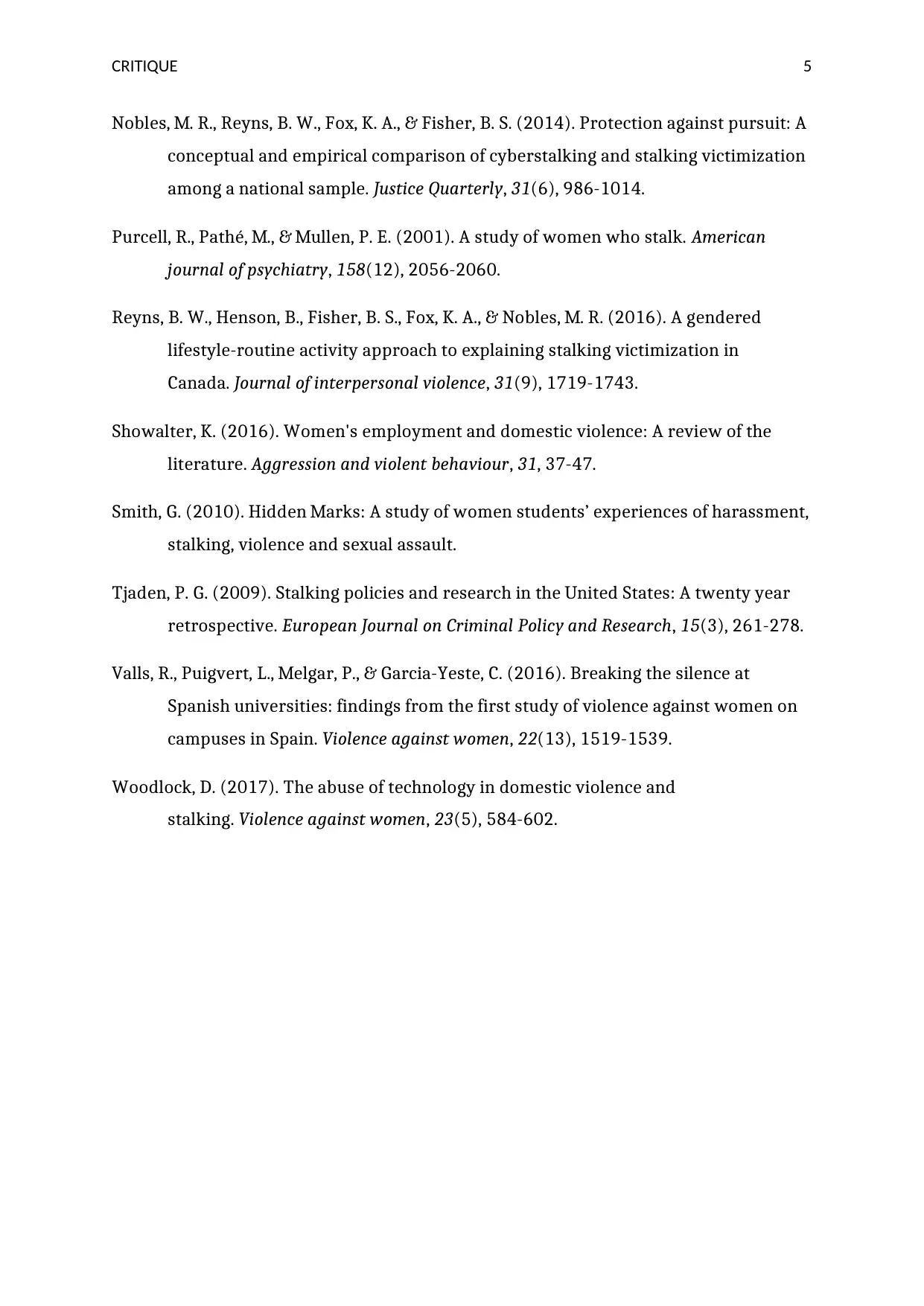
CRITIQUE 5
Nobles, M. R., Reyns, B. W., Fox, K. A., & Fisher, B. S. (2014). Protection against pursuit: A
conceptual and empirical comparison of cyberstalking and stalking victimization
among a national sample. Justice Quarterly, 31(6), 986-1014.
Purcell, R., Pathé, M., & Mullen, P. E. (2001). A study of women who stalk. American
journal of psychiatry, 158(12), 2056-2060.
Reyns, B. W., Henson, B., Fisher, B. S., Fox, K. A., & Nobles, M. R. (2016). A gendered
lifestyle-routine activity approach to explaining stalking victimization in
Canada. Journal of interpersonal violence, 31(9), 1719-1743.
Showalter, K. (2016). Women's employment and domestic violence: A review of the
literature. Aggression and violent behaviour, 31, 37-47.
Smith, G. (2010). Hidden Marks: A study of women students’ experiences of harassment,
stalking, violence and sexual assault.
Tjaden, P. G. (2009). Stalking policies and research in the United States: A twenty year
retrospective. European Journal on Criminal Policy and Research, 15(3), 261-278.
Valls, R., Puigvert, L., Melgar, P., & Garcia-Yeste, C. (2016). Breaking the silence at
Spanish universities: findings from the first study of violence against women on
campuses in Spain. Violence against women, 22(13), 1519-1539.
Woodlock, D. (2017). The abuse of technology in domestic violence and
stalking. Violence against women, 23(5), 584-602.
Nobles, M. R., Reyns, B. W., Fox, K. A., & Fisher, B. S. (2014). Protection against pursuit: A
conceptual and empirical comparison of cyberstalking and stalking victimization
among a national sample. Justice Quarterly, 31(6), 986-1014.
Purcell, R., Pathé, M., & Mullen, P. E. (2001). A study of women who stalk. American
journal of psychiatry, 158(12), 2056-2060.
Reyns, B. W., Henson, B., Fisher, B. S., Fox, K. A., & Nobles, M. R. (2016). A gendered
lifestyle-routine activity approach to explaining stalking victimization in
Canada. Journal of interpersonal violence, 31(9), 1719-1743.
Showalter, K. (2016). Women's employment and domestic violence: A review of the
literature. Aggression and violent behaviour, 31, 37-47.
Smith, G. (2010). Hidden Marks: A study of women students’ experiences of harassment,
stalking, violence and sexual assault.
Tjaden, P. G. (2009). Stalking policies and research in the United States: A twenty year
retrospective. European Journal on Criminal Policy and Research, 15(3), 261-278.
Valls, R., Puigvert, L., Melgar, P., & Garcia-Yeste, C. (2016). Breaking the silence at
Spanish universities: findings from the first study of violence against women on
campuses in Spain. Violence against women, 22(13), 1519-1539.
Woodlock, D. (2017). The abuse of technology in domestic violence and
stalking. Violence against women, 23(5), 584-602.
⊘ This is a preview!⊘
Do you want full access?
Subscribe today to unlock all pages.

Trusted by 1+ million students worldwide
1 out of 6
Related Documents
Your All-in-One AI-Powered Toolkit for Academic Success.
+13062052269
info@desklib.com
Available 24*7 on WhatsApp / Email
![[object Object]](/_next/static/media/star-bottom.7253800d.svg)
Unlock your academic potential
Copyright © 2020–2025 A2Z Services. All Rights Reserved. Developed and managed by ZUCOL.





